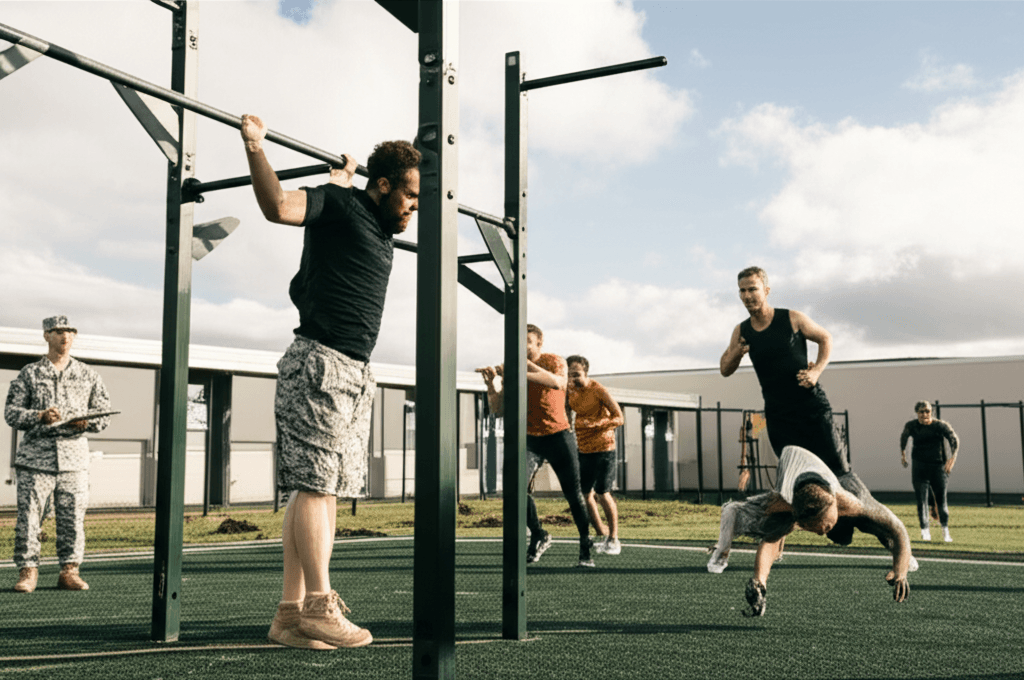Preparing for military training demands a comprehensive and rigorous fitness regimen that builds strength, endurance, and mental toughness. Unlike standard gym routines, military fitness prioritizes functional movements that mimic the physical challenges encountered in service. This guide outlines the key components of a workout program designed to get you combat-ready.

Understanding Military Fitness Demands
Military training, often referred to as boot camp, prepares recruits for all facets of service—physical, mental, and emotional. Each branch of the military has its specific physical fitness requirements, which often include timed runs, push-ups, sit-ups, and in some cases, pull-ups, planks, and swimming. The Army’s Combat Fitness Test (ACFT), for example, includes a two-mile run, deadlifts, hand-release push-ups, and a sprint-drag-carry. The Navy’s Physical Readiness Test (PRT) also incorporates a 1.5-mile run, push-ups, and a plank, with a 500-yard swim as an alternate cardio option.
Crucially, military fitness is about being resilient, adaptable, and prepared for a wide variety of physical challenges, not just isolated muscle groups or aesthetics.

Core Components of a Military Preparation Workout
A well-rounded military workout plan should integrate strength training, cardiovascular activities, calisthenics, and functional movements.
Calisthenics: Building Foundational Strength
Calisthenics, exercises using only body weight, are a cornerstone of military fitness, building strength, endurance, and agility. These functional movements are essential for developing a combat-ready physique without the need for gym equipment.
Key calisthenics exercises include:
- Push-ups: Standard, diamond, and wide-arm variations.
- Pull-ups: Regular, chin-ups, and commando pull-ups are crucial for upper body and grip strength. If pull-ups are challenging, start with pulldowns or assisted pull-ups.
- Sit-ups and Crunches: Essential for core endurance. While some branches are transitioning to planks, sit-ups remain a classic for core strength.
- Squats and Lunges: Bodyweight squats, jumping lunges, and weighted variations build lower body strength and endurance.
- Burpees: A full-body conditioning movement that combines a squat, push-up, and jump, enhancing cardiovascular fitness and muscle endurance.
- Planks: Excellent for core stability and endurance, often replacing sit-ups in modern military fitness tests.
- Dips: Target triceps and shoulder endurance.
A full-body calisthenics routine could involve a pyramid warm-up (e.g., 1-10 reps of pull-ups, push-ups, and squats with 100-meter jogs between sets), followed by circuits mixing these exercises with minimal rest.
Cardiovascular Endurance: Running and Rucking
Running and rucking (walking with a weighted backpack) are vital for military training, building cardiovascular fitness, stamina, and mental toughness.
Running
Running is a critical component of military fitness tests across all branches.
- Distance and Pace: Military runs typically range from 1.5 to 3 miles. For example, the Army’s ACFT requires a two-mile run, with a passing time for males aged 17-21 of 22 minutes or less, and a perfect score (100) requiring a time of 13:22 or faster. The Navy PRT requires a 1.5-mile run.
- Training Strategy:
- Foundation and Endurance (Weeks 1-4): Focus on easy-paced long runs (gradually increasing from 3 to 5 miles), moderate-paced runs (2-4 miles), and interval training (e.g., 400-meter intervals).
- Speed and Strength (Weeks 5-8): Incorporate tempo runs (challenging but manageable pace for 3-5 miles), hill repeats (60-90 second uphill runs), and speed intervals (200-meter fast pace alternated with 200-meter recovery jog).
- Peaking and Tapering (Weeks 9-12): Longer runs at a controlled pace (up to 8-10 miles), race-pace runs (4-6 miles), and a combination of tempo and interval work.
- Interval Training: Workouts like the Norwegian 4×4, which involves four-minute intense runs followed by three minutes of active recovery, can improve VO2 max. The 100-100 workout (100m fast run, 100m easy jog, repeated 10 times) is another effective sprint/conditioning exercise.
- Running Form: The Pose Method of Running, which focuses on running skill and injury prevention, has been integrated into the updated US Army Holistic Health And Fitness Field Manual (FM 7-22).
Rucking
Rucking involves walking with weight on your back, engaging multiple muscle groups and improving strength, endurance, and mental toughness. It’s a low-impact exercise that builds strength and muscle while improving cardio.
- Starting Out: Begin with 1-2 rucks per week, taking rest days between efforts. Start with a lighter weight and gradually increase the weight and distance.
- Weight Progression: Slowly add 5-10 pounds every 2-3 weeks, working up to a weight you can handle for 45- to 60-minute walks. Military standards can involve carrying a minimum of 35 lbs, with total loads up to 70 lbs for a 12-mile march.
- Pace: The Army’s minimum rucking standard is a 15-minute mile, which can be maintained with a brisk walk. While running with a rucksack is done in military training, it’s generally not recommended for civilian training due to injury concerns; ruck shuffling (Airborne Shuffle) offers a safer alternative for increasing tempo.
- Complementary Training: Incorporate weighted squats, lunges, deadlifts, and stair climbing to strengthen legs and back for rucking.
Strength Training: Compound Movements
While calisthenics form a strong base, incorporating compound strength training movements can further enhance military preparedness.
- Key Lifts: Squats, deadlifts, and bench presses build overall strength, power, and muscle.
- Functional Focus: Military-style training prioritizes movements that mimic real-world challenges, emphasizing functional fitness. A leg circuit with carries and crawls, combining weighted squats, kettlebell Romanian deadlifts, farmer walks, and bear crawling, is an example of such functional training.
- Grip Strength: Exercises that train grip, such as weighted carries, are crucial for rucking and other military tasks.

Specialized Considerations
Swimming
While not all branches require swimming proficiency for basic training (e.g., the U.S. Army and Air Force do not have mandatory swimming tests for recruits), it is a requirement for the Navy and Marine Corps, and essential for special operations forces, divers, and rescue swimmers.
- Navy Requirements: The Navy’s PRT may include a 500-yard swim as an alternate to the 1.5-mile run.
- Training Progression: If you are new to swimming, start with basic stroke mechanics and build up to continuous swimming. A common progression involves warming up with a 500-meter swim, then performing repeated sets of 50-meter or 100-meter swims with minimal rest, focusing on efficiency and conditioning.
- Technique: Focus on effective underwater swimming techniques, including proper push-offs, flutter kicks, and breaststroke kicks.
Recovery and Balance
Intense training requires adequate recovery. Incorporate core balancing exercises to support recovery and improve posture and hip function. Examples include reverse push-ups, bird-dog, arm haulers, swimmers, side planks, dirty dogs, and donkey kicks. A structured workout plan, such as a 12-week program, often includes dedicated rest days or lighter training days to allow for recovery and adaptation.

Sample Workout Structures
Military workout programs often follow a structured, multi-week approach, gradually increasing intensity and volume. For example, a 12-week program might involve workouts four times a week, with no more than two consecutive training days.
A general full-body military fitness workout might include:
- Warm-up: Squat pyramid (1-10 squats with 100-meter jogs in between sets) or a pull-up/push-up/squat half pyramid.
- Leg Circuit with Carries and Crawls: Weighted squats, kettlebell Romanian deadlifts, farmer walks/fireman carries, bear crawling, and lunging for 100 meters each, followed by a 400-800 meter run. Repeat this circuit four times.
- Upper Body: Bench press, dumbbell rows, and dumbbell military press.
- Calisthenics Circuit: Max effort sets of pull-ups, squats, push-ups, lunges, and abdominal exercises, with optional cardio.
- Cool-down: Flexibility and mobility exercises.
Ultimately, consistent effort, a focus on functional movements, and progressive overload across all fitness domains—strength, endurance, and power—will best prepare you for the demands of military training.






